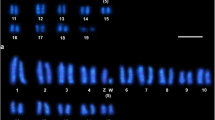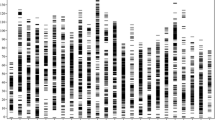Abstract
In the present study, the first genetic linkage map of the loach Misgurnus anguillicaudatus was constructed with 164 microsatellite markers and a color locus, and it included 155 newly developed markers. A total of 159 microsatellite markers and a color locus were mapped in 27 linkage groups (LGs). The female map covered 784.5 cM with 153 microsatellite markers and a color locus, whereas the male map covered 662.2 cM with 119 microsatellite markers. The centromeric position in each LG was estimated by marker-centromere mapping based on half-tetrad analysis. In 4 LGs (LG2, LG3, LG4, and LG5), the centromere was estimated at the intermediate region. In LG1, LG11, and LG12, the centromere was estimated to shift from the sub-intermediate region to the end (telomeric). The number of these LGs (7) was identical to the collective number of bi-arm metacentric (5) and sub-metacentric chromosome (2) of the haploid chromosome set (n = 5) of the loach. In the other LGs, the position of the centromere was estimated at the end or outside. These results indicate satisfactory compliance between the linkage map and the chromosome set. Our map would cover approximately almost the entire loach genome because most markers were successfully mapped.


Similar content being viewed by others
References
Agresti JJ, Seki S, Cnaani A, et al (2000) Breeding new strains of tilapia: development of an artificial center of origin and linkage map based on AFLP and microsatellite loci. Aquaculture 185:43–56
Arai K (2003) Genetics of the loach, Misgurnus anguillicaudatus: recent progress and perspective. Folia Biol (Krakow) 51(Suppl):107–117
Arai K, Mukaino M (1997) Clonal nature of gynogenetically induced progeny of triploid (diploid x tetraploid) loach Misgurnus anguillicaudatus (Pisces: Cobitididae). J Exp Zool 278:412–421
Arai K, Matsubara K, Suzuki R (1991) Karyotype and erythrocyte size of spontaneous tetraploidy and triploidy in the loach, Misgurnus anguillicaudatus. Nippon Suisan Gakkaishi 57:2157–2172
Catanach AS, Erasmuson SK, Podivinsky E et al (2006) Deletion mapping of genetic regions associated with apomixis in Hieracium. Proc Natl Acad Sci USA 103:18650–18655
Chistiakov DA, Hellemans B, Haley CS et al (2005) A microsatellite linkage map of the European sea bass Dicentrarchus labrax L. Genetics 170:1821–1826
Coimbra MRM, Kobayashi K, Koretsugu S et al (2003) A linkage map of the Japanese flounder, Paralichthys olivaceus. Aquaculture 220:203–218
Dawley RM (1989) An introduction to unisexual vertebrates. In: Dawley RM,Bogart TJP (eds) Evolution and Ecology of Unisexual Vertebrates. Bulletin 466, New York State Museum, Albany, pp 1–18
Dawley RM (1992) Clonal hybrids of the common laboratory fish Fundulus heteroclitus. Proc Natl Acad Sci USA 89:2485–2488
Estoup A, Presa P, Krieg F et al (1993) (CT) n and (GT) n microsatellites: a new class of genetic markers for Salmo trutta L (brown trout). Heredity 71:488–496
Gharbi K, Gautier A, Danzmann RG et al (2006) A linkage map for brown trout (Salmo trutta): chromosome homeologies and comparative genome organization with other salmonid fish. Genetics 172:2405–2419
Grattapaglia D, Sederoff R (1994) Genetic linkage maps of Eucalyptus grandis and Eucalyptus urophylla using a pseudo-testcross: mapping strategy and RAPD markers. Genetics 137:1121–1137
Ito T, Smith CL, Cantor CR (1992) Triplex affinity capture of a single copy clone from a yeast genomic library. Nucl Acids Res 20:3524
Itono M, Morishima K, Fujimoto T et al (2006) Premeiotic endomitosis produces diploid eggs in the natural clonal loach, Misgurnus anguillicaudatus (Teleostei:cobitidae). J Exp Zool 305:513–523
Itono M, Okabayash N, Morishima K et al (2007) Cytological mechanisms of gynogenesis and sperm incorporation in unreduced diploid eggs of the clonal loach, Misgurnus anguillicaudatus (Teleostei: Cobitidae). J Exp Zool 307A:35–50
Kim LS, Lee EH (2000) Hybridization experiment of diploid-triploid cobitid fishes, Cobitis sinensis-longicorpus complex (Pisces: Cobitidae). Folia Zool 49(Suppl 1):17–22
Kocher TD, Lee WJ, Sobolewska H et al (1998) A genetic linkage map of a cichlid fish, the tilapia (Oreochromis niloticus). Genetics 148:1225–1232
Lee BY, Lee WJ, Streelman JT et al (2005) A second-generation genetic linkage map of tilapia (Oreochromis spp). Genetics 170:237–244
Lindner KR, Seeb JE, Habicht C et al (2000) Gene-centromere mapping of 312 loci in pink salmon by half-tetrad analysis. Genome 43:538–549
Liu Z, Karsi A, Li P et al (2003) An AFLP-based genetic linkage map of channel catfish (Ictalurus punctatus) constructed by using an interspecific hybrid resource family. Genetics 165:687–694
Malicki JJ, Pujic Z, Thisse C et al (2002) Forward and reverse genetic approaches to the analysis of eye development in zebrafish. Vision Res 42:527–533
Moen T, Hoyheim B, Munck H et al (2004) A linkage map of Atlantic salmon (Salmo salar) reveals an uncommonly large difference in recombination rate between the sexes. Animal Genetics 35:81–92
Morishima K, Nakayama I, Arai K (2001) Microsatellite-centromere mapping in the loach, Misgurnus anguillicaudatus. Genetica 111:59–69
Morishima K, Horie S, Yamaha E et al (2002) A cryptic clonal line of the loach Misgurnus anguillicaudatus (Teleosti: Cobitidae) evidenced by induced gynogenesis, interspecific hybridization, microsatellite genotyping and multilocus DNA fingerprinting. Zool Sci 19:565–575
Morishima K, Oshima K, Horie S et al (2004) Clonal diploid sperm of the diploid-triploid mosaic loach, Misgurnus anguillicaudatus (Teleostei:Cobitidae). J Exp Zool 301A:502–511
Naruse K, Fukamachi S, Mitani H et al (2000) A detailed linkage map of medaka, Oryzias latipes: comparative genomics and genome evolution. Genetics 154:1773–1784
Naruse K, Tanaka M, Mita K et al (2004) A medaka gene map: the trace of ancestral vertebrate proto-chromosomes revealed by comparative gene mapping. Genome Res 14:820–828
Ojima Y, Takai A (1979) The occurrence of spontaneous polyploid in the Japanese common loach Misgurnus anguillicaudatus. Proc Japan Acad 55B:487–491
Oshima K, Morishima K, Yamaha E et al (2005) Reproductive capacity of triploid loaches obtained from Hokkaido Island, Japan. Ichthyol Res 52:1–8
Postlethwait JH, Johnson SL, Midson CN et al (1994) A genetic linkage map for the zebrafish. Science 264:699–703
Prochazka M (1996) Microsatellite hybrid capture technique for simultaneous isolation of various STR markers. Genome Res 6:646–649
Sakamoto T, Danzmann RG, Gharbi K et al (2000) A microsatellite linkage map of rainbow trout (Oncorhynchus mykiss) characterized by large sex-specific differences in recombination rates. Genetics 155:1331–1345
Shimoda N, Knapik EW, Ziniti J et al (1999) Zebrafish genetic map with 2000 microsatellite markers. Genomics 58:219–232
Singer A, Perlman H, Yan Y et al (2002) Sex-specific recombination rates in zebrafish (Danio rerio). Genetics 160:649–657
Steven C, Comber LE, Smith CARL (2004) Polyploidy in fishes: patterns and processes. Biol J Linn Soc 82:431–442
Sun X, Liang L (2004) A genetic map of common carp (Cyprinus carpio L) and mapping of a locus associated with cold tolerance. Aquaculture 238:165–172
Suzuki R, Oshiro T, Nakanishi T (1985) Survival, growth and fertility of gynogenetic diploids induced in the cyprinid loach, Misgurnus anguillicaudatus. Aquaculture 48:45–55
Talbot WS, Schier AF (1999) Positional cloning of mutated zebrafish genes. Methods Cell Biol 60:259–286
Thorgaard GH, Allendorf FW, Knudsen KL (1983) Gene-centromere mapping in rainbow trout: high interference over long map distance. Genetics 103:771–783
Vijverberg K, van der Hulst , van der Hulst RG et al (2004) A genetic linkage map of the diplosporous chromosomal region in Taraxacum officinale (common dandelion; Asteraceae). Theor Appl Genet 108:725–732
Waldbieser GC, Bosworth BG, Nonneman DJ et al (2001) A microsatellite-based genetic linkage map for channel catfish, Ictalurus punctatus. Genetics 158:727–734
Yoshikawa H, Morishima K, Kusuda S et al (2007) Diploid sperm produced by artificially sex-reversed clone loaches. J Exp Zool 307A:75–83
Zhang Q, Arai K (1999) Distribution and reproductive capacity of natural triploid individuals and occurrence of unreduced eggs as a cause of polyploidization in the loach, Misgurnus anguillicaudatus. Ichthyol Res 46:153–161
Zhao H, Speed TP (1998) Statistical analysis of half-tetrads. Genetics 150:473–485
Zhou YT, Bui LD Auckland, Williams CG (2002) Direct fluorescent primers are superior to M13-tailed primers for Pinus taeda microsatellites. Biotechniques 32:46–52
Acknowledgements
We thank Prof. Heisuke Nakagawa and Dr. Tetsuya Umino, Laboratory of Aquaculture, Graduate School of Biosphere Science, Hiroshima University, for their advice on the present study. This study was supported in part by a Grant-in-Aid for 21stCentury COE (Center of Excellence) Program from the Ministry of Education, Culture, Sports, Science and Technology (MEXT) and by Scientific Research (B)(No18380108) from the Japanese Society for the Promotion of Science (JSPS) awarded to Katsutoshi Arai.
Author information
Authors and Affiliations
Corresponding author
Rights and permissions
About this article
Cite this article
Morishima, K., Nakayama, I. & Arai, K. Genetic linkage map of the loach Misgurnus anguillicaudatus (Teleostei: Cobitidae). Genetica 132, 227–241 (2008). https://doi.org/10.1007/s10709-007-9165-2
Received:
Accepted:
Published:
Issue Date:
DOI: https://doi.org/10.1007/s10709-007-9165-2




